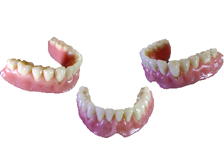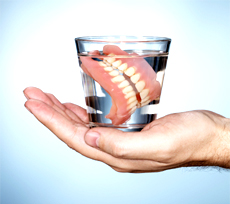

Home »
Our Services » Dentures
Dentures
Complete Dentures
 |
Conventional and Immediate are the two types of
dentures available. A conventional denture is manufactured and
positioned in the patient's oral cavity after the remaining teeth are
extracted and tissues have recovered. The procedure can last for some
months. Unlike Conventional appliance, Immediate appliance is placed as
soon as the remaining teeth are extracted. Immediate appliance's main
benefit is that the patient does not have to stay without teeth. During
the healing period, gum and bone shrinkage occurs due to which the
immediate appliance has to be realigned. After the recovery is complete,
a conventional appliance is then made.
Manufacturing a Complete Denture
 |
Every minute detail has to be considered while
fabricating a complete denture as ignoring even the smallest factor can
cause failure. In many cases, the appliance is required to fit easily
soon after being placed. One of the most significant fact of the
procedure is that the imprint must be faultless and the technique
implied to make it must be flawless. Border molding process must be used
by the dentist to avoid the aggressive collision of the denture with the
edges of the oral cavity. Patience is essential while designing a
denture and even the slightest of mistake and cause a whole assortment
of problems later.
The stable alignment and low slippage makes full upper denture easy to design. In case of lower appliances, the dentist recommends using 3-4 implants in lower jaw as support due to lack of ''suction'' to maintain the appliance in its position. The one big benefit of using implants as support is that the patient can enjoy biting an apple or a corn which becomes extremely difficult without implants.
Statistics have shown full dentures have less biting power than natural teeth and do not always fit comfortably. Such patients need to realize that while upper denture can remain stable without implants, lower denture cannot. Hence, dentist always recommend of keeping as many natural teeth as one can especially in the lower jaw.
The stable alignment and low slippage makes full upper denture easy to design. In case of lower appliances, the dentist recommends using 3-4 implants in lower jaw as support due to lack of ''suction'' to maintain the appliance in its position. The one big benefit of using implants as support is that the patient can enjoy biting an apple or a corn which becomes extremely difficult without implants.
Statistics have shown full dentures have less biting power than natural teeth and do not always fit comfortably. Such patients need to realize that while upper denture can remain stable without implants, lower denture cannot. Hence, dentist always recommend of keeping as many natural teeth as one can especially in the lower jaw.
Freshly Inserted Dentures
 |
Newly inserted appliance may feel a little
awkward in the initial phase as the tongue and muscles of the cheek are
still adjusting themselves. Minor irritation, tenderness and increased
saliva level are very common and normal problems that a patient faces
after getting new appliance. 1 or 2 visits to the dentist are essential
after insertion.
To avoid appliance slippage, the patient should slowly graduate from easy to chew food to normal diet as this process requires practice. Even after getting used to the appliance, a patient must take extreme care while eating hard food, food with sharp edges and hot food. Food should be chewed by using both sides of the oral cavity simultaneously.
Teeth are necessary to correctly pronounce certain words and reading out loud and repetition of difficult words helps improving diction. Talking slowly helps avoiding ''clicking'' of the appliance. Sporadic slippage might occur while coughing or laughing hard and can be adjusted by gently biting and swallowing. The patient should immediately visit the dentist if any of the above mentioned problems persist.
We will give instructions about the time for which the appliance must be worn. During the initial phase, the patient may be advised to use them most of the time and also while sleeping. After the early adjustment phase, the patient may be asked to not wear them while sleeping. This is done to encourage healing and oral health. As a rule of thumb, the gum tissues should not be continuously surrounded by the appliance.
To avoid appliance slippage, the patient should slowly graduate from easy to chew food to normal diet as this process requires practice. Even after getting used to the appliance, a patient must take extreme care while eating hard food, food with sharp edges and hot food. Food should be chewed by using both sides of the oral cavity simultaneously.
Teeth are necessary to correctly pronounce certain words and reading out loud and repetition of difficult words helps improving diction. Talking slowly helps avoiding ''clicking'' of the appliance. Sporadic slippage might occur while coughing or laughing hard and can be adjusted by gently biting and swallowing. The patient should immediately visit the dentist if any of the above mentioned problems persist.
We will give instructions about the time for which the appliance must be worn. During the initial phase, the patient may be advised to use them most of the time and also while sleeping. After the early adjustment phase, the patient may be asked to not wear them while sleeping. This is done to encourage healing and oral health. As a rule of thumb, the gum tissues should not be continuously surrounded by the appliance.

